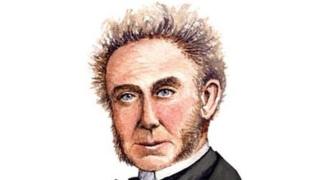Sir Thomas Maclear: Honouring Tyrone’s ‘spectacular’ astronomer – BBC News
 Image copyright Ulster History Circle
Image copyright Ulster History CircleOn Saturday, a blue plaque was put up in Newtownstewart celebrating the life of local astronomer, Sir Thomas Maclear.
But it’s not the only place he’s remembered.
A beacon on top of South Africa’s Table Mountain and a cape in Malawi are named after him. His talents were so out of this world that he even has a crater on the Moon – Maclear – named in his honour.
So who was Thomas Maclear?
Well, meet the astronomer you (probably) haven’t heard of.
Sir Thomas was born in the County Tyrone village in 1794.
He worked as a house surgeon in the Bedford Infirmary after being accepted into the Royal College of Surgeons in 1815.
He developed an interest in astronomy, left the medical profession and went on to become a Fellow of the Royal Astronomical Society in 1828.
In 1833, he was named His Majesty’s Astronomer at the Cape of Good Hope in South Africa.
His work included performing a geodesic survey, to recalculate the earth’s shape and dimensions.
In South Africa in 1865, Sir Thomas created what is now called Maclear’s beacon and is the highest point of Table Mountain.
It was built as a triangular station to assist in measuring the curvature of the Earth.
The beacon is still used by cartographers to this day.
Sir Thomas was knighted in 1860 for his achievement as an astronomer and his work on the cape.
He retired in 1870 and died on 14 July 1879 in Mowbray, Cape Town.
Great-great-great descendant
A special guest unveiled the plaque in Newtownstewart on Saturday – Sir Thomas’ great-great-grandson.
Paul Maclear, 52, is from Johannesburg, South Africa, and lives in Amsterdam in the Netherlands.
“My earliest memory is a couple of books in my dad’s bookcase. My dad was good at keeping that alive and told us things about this chap who did spectacular things,” he tells BBC News NI.
“I think his biggest achievement was to study a miscalculation and what he did was confirm the curvature of the Earth and the fact that the southern pole was not quite as flat as the earlier calculation.
“His legacy would be that re-calculation to prove the shape of the earth as we know today.”
It’s Paul’s first time coming to Northern Ireland, a maiden journey that he is excited to make.
“It’s a great opportunity, unless I’m mistaken I think we are the last descendants in the room really, it’s really interesting and will hopefully be a great day.
“He’s got the moon crater, the town named after him, a cape named after him, a couple of streets in Cape Town named after him- so there’s quite a lot out there!”
‘Modest man’
Mark Bailey, former director of the Armagh Observatory, who is speaking at the event, says Sir Thomas made a big impact on astronomy.
“He observed the stars for the principle of navigation, he studied the southern skies as they looked different in the southern hemisphere,” he says.
“The impact of his positional work on the stars was used in other fields, such as studying the shape of the earth.
“From what I gather, he was a modest man with excellent quality.”
The Ulster History Circle, which makes the blue plaques, added that “it is gratifying that his name lives on in South Africa and will continue to be remembered in his native Newtownstewart”.





